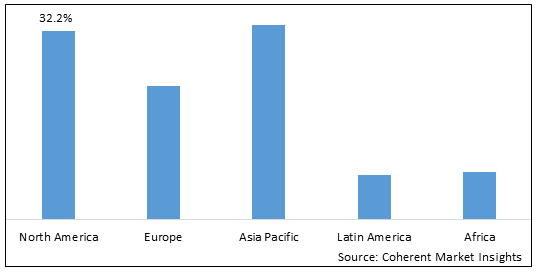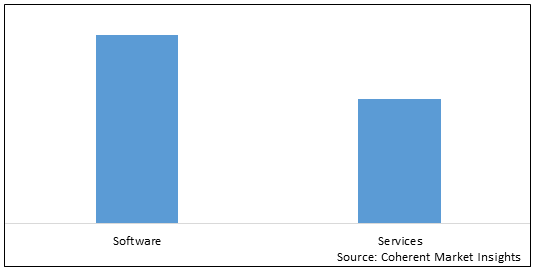Product Lifecycle Management Market is estimated to be valued at USD 35,361.9 Mn in 2025 and is expected to reach USD 64,560.0 Mn in 2032, exhibiting a compound annual growth rate (CAGR) of 8.98% from 2025 to 2032. Production innovation and development are some of the key strategies for the revenue growth of the market. The demand for newer products within small intervals of time or the need for customization according to customer requirements are key characteristics of industrial operations today Currently, product-oriented industries such as manufacturing and pharmaceutical are facing challenges such as increased competition and demand for product customization, in order to cater to specific individual needs and comply with stringent industry regulations.
Figure 1. Global Product Lifecycle Management Market, Revenue Share (%), By Region, 2025

To learn more about this report, Request sample copy
Product lifecycle Management Market Drivers:
Production innovation and development are some of the key strategies for the revenue growth of the market. The demand for newer products within small intervals of time or the need for customization according to customer requirements are key characteristics of industrial operations today. Similarly, companies of PLC market have to collaborate both internally and with partners and suppliers worldwide. Moreover, companies need to manage increasing complexities in the product and the manufacturing processes due to the significant growth of environmental and regulatory requirements. A PLM solution can increase the productivity of a system significantly by providing various sets of tools and methodologies to reduce redundancies. It provides knowledge and support for sharing data within an organization by reducing both risks and product development time. It can reduce the design cycle and tooling preparation time considerably. This, in turn, helps in the introduction of new products to the market and leads to quicker penetration. Product lifecycle management automatically adjusts any feature of design each time a change is made. Therefore, these factors are expected to drive the growth of the global product lifecycle management (PLM) market during the forecast period.
PLM has witnessed massive growth from various End use industries such as aerospace and automotive in the recent past. However, many nonconventional End use sectors such as pharmaceutical, retail, and consumer packaged goods (CPG) are witnessed rapid demand and this demand is expected to increase in the near future. This growth is prevalent in developed countries such as Germany, Japan, and the U.S. These economies have experienced significant adoption of PLM in sectors such as automotive and aerospace, and demand for PLM has reached a level of significant maturity if not complete saturation. Therefore, these factors are expected to propel the global product lifecycle management (PLM) market growth in the near future.
Product lifecycle management Market Opportunities:
Smart factories also referred to as smart manufacturing is highly developed and digitized factory systems that include cyber-physical systems, in which materials can be moved across the factory floor with efficiency. Sensing components such as actuators and sensors within industrial settings are expected to become smart since they are becoming self-efficient with computing abilities and low power consumption. Smart factories consist of data models and both factory-specific and manufacturing execution system (MES) templates for rapid use. The benefits from PLM in the long term cannot be gained without a digital or smart manufacturing strategy. Product lifecycle management is expected to emerge as a key point of combination between various floor applications and equipment in a smart factory setup, allowing the exchange of information related to the product between the designing and manufacturing groups.
Small- and medium-sized enterprises prefer those products that support their business processes in order to get a low total cost of ownership (TCO). However, growing competition due to factors such as globalization, new entrants, and substitute products has put more pressure on SMEs to optimize their processes in order to function effectively. Smaller enterprises can use PLM solutions as a go-to-market strategy for managing growth, as well as for enhancing future visibility of the market and better communication in the supply chain. PLM solution providers are beginning to recognize the growth potential of non-traditional markets. They are increasingly trying to tailor their offerings toward the SMEs, which were hesitant about investing in new technologies.
Product Lifecycle Management Market Report Coverage
| Report Coverage | Details | ||
|---|---|---|---|
| Base Year: | 2024 | Market Size in 2025: | USD 35,361.9 Mn |
| Historical Data for: | 2020 To 2024 | Forecast Period: | 2025 To 2032 |
| Forecast Period 2025 to 2032 CAGR: | 8.98% | 2032 Value Projection: | USD 64,560.0 Mn |
| Geographies covered: |
|
||
| Segments covered: |
|
||
| Companies covered: |
Dassault Systems, Hewlett-Packard Company, PTC, Inc., Atos SE, Siemens AG, Accenture plc, Autodesk, Inc., IBM Corporation, SAP SE, and Aras Corporation. |
||
| Growth Drivers: |
|
||
| Restraints & Challenges: |
|
||
Uncover macros and micros vetted on 75+ parameters: Get instant access to report
Product lifecycle management Market Trends:
Product development in all industry sectors demands smart and connected products; this includes cars, appliances, consumer products, and mobile devices. In a fundamental shift related to product design, all products are at present designed to be intelligent, connected, and also fit the ecosystem in which they are functioning. Manufacturers are increasingly investing in connected service platforms in order to increase their time savings and reduce operational costs. Furthermore, products are also considerably becoming software-driven and require systems applications to manage the growing process and product complexity. There are various opportunities in design as well as manufacturing for approaches based on the Internet of Things (IoT) which enables the connection between the digital and physical worlds. In order to meet the requirements for IoT, PLM designers are now considering the expansion of functions so as to include connectivity and intelligence. New PLM solutions and service strategies that significantly include the collaboration between enterprise IT, smart-product-related technology, and other pillar technologies, are emerging.
PLM vendors are taking steps to shift toward cloud-based PLM implementations as cloud adoption in enterprises matures. Furthermore, in recent years, PLM analytics has experienced increased demand as manufacturers need to leverage product data for more informed decision-making. It is anticipated that offering cloud-based analytics for PLM data would be a key trend in the near future.
Product Lifecycle Management Market Restraints:
SMEs have a significant contribution to global economies. PLM exposure has been limited to industries with variable, complex product lines and large supplier networks, particularly the automotive, electronics, and aerospace sectors. Mid-sized enterprises recognize the importance of PLM, however, they are hesitant about implementing it, due to the limited nature of their IT resources, the resistance to any standard operating procedures (SOPs) changes, unknown nature of total costs, and the possible disturbance to users. Some of the key challenges faced by SMEs include the high cost of implementation, change in business processes, and shortage of internal resources. Therefore, these factors are expected to restrain the growth of the global product lifecycle management (PLM) market during the forecast period.
Mapping new attributes to product data is generally a time- and resource-intensive process. However, companies need to be sure that work should be completed before the migration of any data or the system will be of no worth. One of the challenges faced by PLM is getting complete control of product-related data. Even with a successful implementation of PLM, data is scattered between the various data sources. Moreover, product-related data can be located in a diverse set of applications that are significantly used for product development. The value of PLM directly depends on how and what scope of product-related data is used by PLM. There is a need for interoperability between different product versions, competitive products, data formats, data models, and databases among customers. Hence, these factors are expected to hamper the global lifecycle management (PLM) market growth over the forecast period.
Figure 2: Global Product Lifecycle Management Market Share (%), By Segment, 2025

To learn more about this report, Request sample copy
Product lifecycle management Market Segmentation:
Product lifecycle management Market is segmented by component into (Software (On-premise (Cax, NC, S&A, AEC, CPDM, Digital Manufacturing, EDA, Others), Cloud Based (Cax, NC, S&A, AEC, CPDM, Digital Manufacturing, EDA, Others)), and Services (Consulting, Integration, and Operation and Maintenance). By End use (Automotive and Transportation, Aerospace and Defense, Industrial Machinery and Heavy Equipment, Electronics and Semiconductor, Energy and Utilities, Consumer Products and Retail, Medical Devices and Pharmaceutical, IT and Telecom, and Others (Marine, Chemical)
Product Lifecycle Management Market Market: Key Developments
*Definition: Product lifecycle management (PLM) is a method of managing a product throughout its lifetime including maintenance, development, production, and recycling phases. PLM is crucial in enterprises that support the concept, design & engineering, management of product portfolios, and cost optimization. It allows effective collaborative working at every stage, enhancing the way the entire business operates.
Share
Share
About Author
Ankur Rai is a Research Consultant with over 5 years of experience in handling consulting and syndicated reports across diverse sectors. He manages consulting and market research projects centered on go-to-market strategy, opportunity analysis, competitive landscape, and market size estimation and forecasting. He also advises clients on identifying and targeting absolute opportunities to penetrate untapped markets.
Missing comfort of reading report in your local language? Find your preferred language :
Transform your Strategy with Exclusive Trending Reports :
Frequently Asked Questions
Select a License Type
Credibility and Certifications

860519526

9001:2015
27001:2022


Joining thousands of companies around the world committed to making the Excellent Business Solutions.
View All Our Clients
US Reciprocal Tax Impact Analysis On Product Lifecycle Management Market
Stay updated on tariff changes with expert insights and timely information